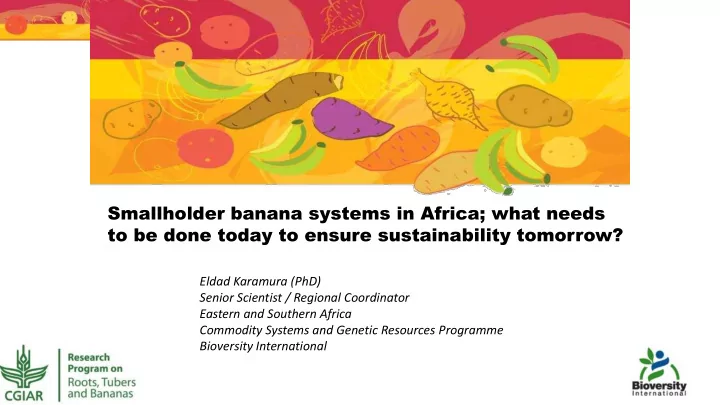

Smallholder banana systems in Africa; what needs to be done today to ensure sustainability tomorrow? Eldad Karamura (PhD) Senior Scientist / Regional Coordinator Eastern and Southern Africa Commodity Systems and Genetic Resources Programme Bioversity International
Presentation content • General context • Systems characteristics in Africa • Systems production constraints • Which solution options? • Research Options
General context xt for th the banana smallholder systems in in Afr Africa • Slow-changing and rural-based economies; • Increased competition for land, water, energy, and other inputs linked to rapid population growth (2.5 – 3.5% annually); • Climate change poses challenges to agriculture, particularly in African countries with increasing temperatures and shorter rain seasons;
General context xt cont’d • Many farming practices damage the environment and may be a major source of greenhouse gases (GHG); • Changing social structures due to HIV- AIDS, rural-to-urban migration and declining returns from agriculture; • Ensuring sustainability of smallholder systems in Africa will demand radical recasting of banana production systems to achieve major productivity increases while reducing environmental impact.
Systems Characteristics: 1. Farm sizes 50 45 40 35 Percentage 30 25 20 15 10 5 0 >0-2 >2-4 >4-6 >6-8 >8-10 >10-15 >15-20 >20-40 Acres Uganda Tanzania Kenya Intensively cultivated;highly fragmented
Systems Characteristics cont’d 2. Dietary importance of banana in ECA
Systems Characteristics cont’d 3. Pests and diseases: no major change in types but serious changes in intensity Staver (2000) Viljoen (2010) Blomme et al 2012 Black leaf spots Xanthomonas Banana Weevil ( M.fijiensis & Cladosporium ) Nematode Fusarium wilt Nematodes Weevil Black leaf streak BBTD Fusarium Nematodes BSV Viruses Banana Weevil Mycosphaerella leaf spots Viruses Viruses Xanthomonas wilt Fusarium
Systems Characteristics cont’d 4. Share of cultivar groups in Eastern and Southern Africa subsample (N = 147)
Systems Characteristics cont’d 5.Highly intensively managed systems Vari riety Selection Varieties mixes Intercrops Enhancing g plant vigour Manure /mulch application Soil-water conservation Plant spacing Exclusion methods ds Rouging / pruning Manipulation of planting dates Gener Generall ally, lo , low input w input : : lo low out w output s put sys ystems tems 9
Systems production constraints ts Top 10 major yield constraints in smallholder systems ESA Yield Constraint Global rank Average points allocated (out of 120 points) BARNESA ECA region Southern Africa BXW 10 12.00 13.98 0.91 Infected planting 1 11.59 11.79 10.50 material Water deficit 3 8.74 8.69 9.00 N-deficiencies 11 5.65 5.70 5.36 K-deficiencies 12 5.26 5.34 4.82 BBTD 9 5.01 3.34 14.36 Banana weevil 6 4.94 5.33 2.82 Fusarium wilt 4 4.98 4.87 5.59 Nematodes 8 4.86 4.93 4.41 Non-uniform 5 4.61 4.81 3.50 planting material
Systems production constraints ts Yield All Major cultivar groups Constraint BARNES Cavendish Other EAHB AAA Beer banana Major yield constraints A AAA dissert (n=88) ABB (n=8) by cultivar group (ESA) (n=37) AAA (n=7) BXW 12.00 3.74 7.14 16.14 5.58 Infected pm 11.59 10.49 9.29 12.48 9.13 Water deficit 8.74 8.83 13.57 8.80 5.38 N-deficiencies 6.56 5.63 5.57 5.82 5.38 K-deficiencies 5.26 4.80 4.71 5.53 5.25 BBTD 5.01 6.66 6.71 3.65 13.38 Banana weevil 4.94 2.74 1.57 6.28 2.88 Fusarium wilt 4.98 5.60 5.43 3.94 3.75 Nematodes 4.86 4.71 3.14 5.23 1.50 Non-uniform 4.61 5.54 3.71 4.44 2.63 pm
Systems production constraints cont’d Aver erage ge weight (% of eight (% of total points alloca total points allocated) ted) assigned assigned to cate to ca tegories gories of of yield yield-limiting limiting factor actors From: Diemuth Pemsl and Charles Staver, 2014
Which solu lution opti tions? Top 10 income increasing factors From: Diemuth Pemsl and Charles Staver, 2014
Research options identified for assessment 1. Integrated management of XW and other bacterial diseases • GM EAHB AAA variety resistant to bacterial wilt • Improved cultural practices & low cost diagnostic kit 2. Recovery of production affected by banana bunchy top virus (BBTV) 3. Sustainable Fusarium Wilt management system 4. Developing banana varieties resistant to major pests and diseases • EAHB AAA resistant to nematodes (N), weevils, black leaf streak • AAB Plantain resistant to BLS, N, weevils + improved quality traits • Sweet acid banana resistant to FOC, BLS, N + improved quality traits 5. Developing strategies and tools for disease surveillance, quarantine and containment Note: Research options with preliminary assessment in green font
Research options identified for assessment 6. Better use / availability of existing genetic diversity for (a)biotic stress and consumer acceptability 7. Sustainable intensification of banana-based cropping systems 8. Rapid and enhanced genetic gains by diploid breeding 9. Reducing losses, expanding utilization of banana products and waste: • Reducing post-harvest losses and waste and/or expanding use of waste, decreasing processing costs and increasing income for small- scale producers/processors through improving post-harvest systems (just in time supply); • Processing and value addition (developing rural agri-business options for improved income and gender equity) Note: Research options with preliminary assessment in green font
Thank you
Recommend
More recommend